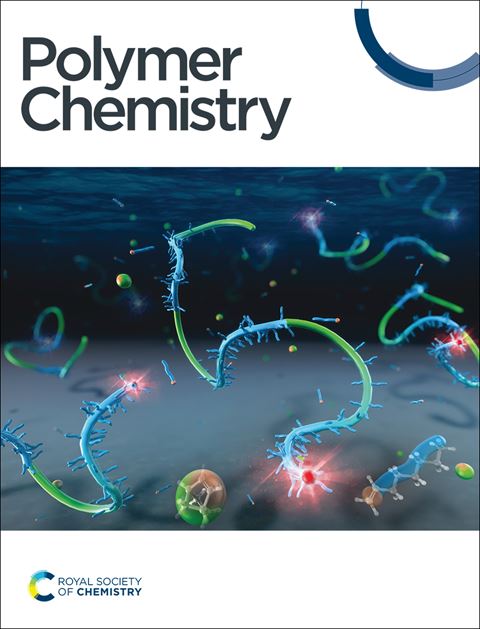含β-吡啶氨基配体的双金属铝配合物:合成、表征及其在ε-己内酯开环聚合中的应用
IF 3.9
2区 化学
Q2 POLYMER SCIENCE
引用次数: 0
摘要
高收率制备了一系列桥接β-吡啶基-对氨基双核铝配合物1 - 6,其中配合物1、2、3、5和6用单晶x射线衍射进行了表征。1-3两个Al中心之间的距离在3.7 ~ 5.8 Å之间,远小于5和6的距离(约8.0 Å)。这些铝配合物均作为引发剂在苯甲醇存在下进行了ε-己内酯开环聚合反应。在相同的条件下,配合物1 ~ 3的催化活性高于配合物4 ~ 6,说明Al原子之间的距离对催化活性有影响。含有Al-Me基团的配合物3和5比含有Al-Et基团的配合物4和6具有更高的催化活性。这可能是由于较大的位阻或给电子基团削弱了铝的路易斯酸,从而降低了配合物与苯甲醇之间的反应速率。其中,影响ε-己内酯ROP聚合活性的因素有两个:一是双金属体系中两个Al中心之间的距离;另一个是Al原子上的烷基。聚合物的MALDI-TOF质谱分析表明,在这些催化剂的催化下,ε-己内酯的开环聚合得到了分子量可控、分布窄、端基保真度高的线性聚己内酯。本文章由计算机程序翻译,如有差异,请以英文原文为准。
Bimetallic aluminum complexes bearing β-pyridyl-enamino ligands: synthesis, characterization and their applications in the ring-opening polymerization of ε-caprolactone
A series of bridged β-pyridyl-enamino dinuclear aluminum complexes 1–6 have been prepared in high yields, where complexes 1, 2, 3, 5 and 6 were characterized by single-crystal X-ray diffraction. The distance between two Al centers in 1–3 was in the range of 3.7 to 5.8 Å, which is far shorter than that in 5 and 6 (about 8.0 Å). All of these aluminum complexes were used as initiators for the ring-opening polymerization of ε-caprolactone in the presence of benzyl alcohol. Complexes 1–3 exhibited higher catalytic activity compared to complexes 4–6 under the same conditions, indicating that the distance between the Al atoms affects the catalytic activity. Complexes 3 and 5 with Al-Me groups exhibit higher catalytic activity than complexes 4 and 6 with Al-Et groups. This is likely due to the larger steric hindrance or the electron-donating group weakens the Lewis acidity of aluminum, which results in a reduced reaction rate between the complexes and benzyl alcohol. Herein, there are two factors affecting the polymerization activity in the ROP of ε-caprolactone: one is the distance between the two Al centers in bimetallic systems; the other is the alkyl groups on the Al atoms. The MALDI-TOF mass spectrum of the polymers revealed that the ring-opening polymerization of ε-caprolactone catalyzed by these catalysts yields linear polycaprolactones with controlled molecular weights, narrow distributions and end group fidelity.
求助全文
通过发布文献求助,成功后即可免费获取论文全文。
去求助
来源期刊

Polymer Chemistry
POLYMER SCIENCE-
CiteScore
8.60
自引率
8.70%
发文量
535
审稿时长
1.7 months
期刊介绍:
Polymer Chemistry welcomes submissions in all areas of polymer science that have a strong focus on macromolecular chemistry. Manuscripts may cover a broad range of fields, yet no direct application focus is required.
 求助内容:
求助内容: 应助结果提醒方式:
应助结果提醒方式:


